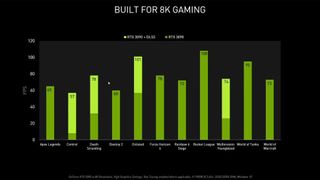Nvidia tells us more about how well the RTX 3090 GPU performs 8K gaming
Ray-traced games require DLSS for smooth frame-rates, unsurprisingly

Nvidia’s GeForce RTX 3090 launch saw the firm declare that its top-end Ampere graphics card can handle 8K gaming smoothly – meaning at 60 frames per second (fps) – but now further details have been shared on what kind of frame-rates we can expect with various games, and perhaps more importantly, how DLSS will fit into the equation when it comes to ray-traced titles.
Bear in mind that as with all the benchmarks shared thus far, these are based on Nvidia’s own internal tests, although this time, some PC spec details have been provided aside from the GPU being used. The RTX 3090 is paired with an Intel Core i9-9900K processor, along with 32GB of system RAM, and the benchmarks are conducted with high graphics settings (but not ultra), with ray tracing enabled wherever supported.
- Find the best Nvidia GPU for you
- Check out all the best PC games
- We'll show you how to build a PC

Running at plain 8K (7,680 x 4,320) resolution in games with no ray tracing, the 3090 dispatches more casual affairs like Rocket League with ease, averaging 108 fps. World of Warcraft sees a result of 73 fps, whereas slightly more demanding shooters still stay just above the magic 60 fps mark: Apex Legends records a result of 65 fps, and Destiny 2 hits 60 fps exactly.
So that’s pretty impressive, but what about those ray-traced games? Death Stranding manages 78 fps, Wolfenstein: Youngblood hits 74 fps, and Control is on 57 fps, but the key point to note here is that this is using DLSS 2.1 to speed those frame-rates.
Without DLSS, Death Stranding and Wolfenstein are around 30 fps (32 fps and 26 fps respectively) – arguably still playable, but not good by any stretch of the imagination – and Control sinks like a stone (8 fps – which just shows how incredibly demanding native 8K with ray tracing can be with all bells and whistles, even for a mighty cutting-edge GPU).
Superpowered scaling?
DLSS 2.1 comes with a new ‘ultra performance mode’ for 8K resolution which means the scaling is ramped up to 9x (‘AI super resolution’ scaling, Nvidia calls it), so in other words, the GPU is taking a 2,560 x 1,440 resolution image and scaling that to 8K.
That’s stretching things considerably more than the current state of play with 4x scaling for 4K rendering – taking 1080p as the base resolution – and as a result, the ‘ultra performance’ scaling with 8K may not generate quite as satisfying results.
Get daily insight, inspiration and deals in your inbox
Get the hottest deals available in your inbox plus news, reviews, opinion, analysis and more from the TechRadar team.
The jury’s still out on that, of course, and we’ll be keen on running our own tests, naturally (benchmarking games at 8K is something we’ve already been doing this year, anyway). But as to how much perceivable difference there will be between 4K and 8K – particularly at greater distances, and if 8K scaling isn’t quite as impressive in terms of detailing – well, there are still question marks around that.
Of course, the other part of the puzzle is that you’ll need an 8K display too, which as we’ve already discussed, is perhaps the first worthwhile reason to upgrade to a new 8K TV. Although if you’re sat across the other side of the room from the display, again, that argument about greater distances and the noticeable difference between 8K and 4K rears its head.
Still, on the face of it – with deep enough pockets and the right display to hand – the RTX 3090 is apparently truly capable of 8K (with considerable assistance from DLSS tech for ray tracing); and we’re doubtless not alone in that we can’t wait to actually see the results ourselves.
Via Tom’s Hardware
Darren is a freelancer writing news and features for TechRadar (and occasionally T3) across a broad range of computing topics including CPUs, GPUs, various other hardware, VPNs, antivirus and more. He has written about tech for the best part of three decades, and writes books in his spare time (his debut novel - 'I Know What You Did Last Supper' - was published by Hachette UK in 2013).
Most Popular


